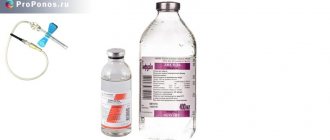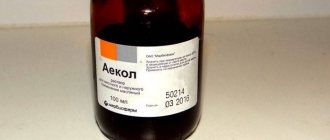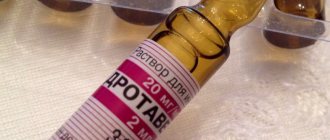Pharmacological action of Ftorotan
According to the instructions, Ftorotan contains a strong active ingredient for inhalation anesthesia - halothane. It acts by inhalation, quickly induces anesthesia, and the stage of excitation is practically absent.
The drug relieves pain and relaxes muscles well, but most often it requires the use of muscle relaxants simultaneously to achieve optimal relaxation. The introduction of anesthesia causes pleasant sensations.
Ftorotan affects the autonomic nervous system, and through this, the condition of internal organs and tissues. Thus, it dilates arterial vessels in the skin and muscles, lowers blood pressure, slows the heart rate, and reduces the contractility of the heart muscle. The heart becomes more sensitive to the influence of adrenaline and other catecholamines, which can provoke arrhythmias.
Also, the influence of the autonomic nervous system causes a moderate bronchodilator effect. Anesthesia with Ftorotan does not increase salivation and secretion of the bronchial glands, weakens uterine contractions in proportion to the depth of anesthesia, and does not change the acid-base balance in the body. The drug inhibits the cough and vomiting centers.
Ftorotan is converted in the liver, excreted from the body by the lungs, partly with bile and urine.
FTOROTANE
FTOROTANE
(
Pthorothanum
; synonym:
Fluothane, Ftorotan, Halothane, Halothanum, Narcotan,
etc.; GFKh sp. B) - a drug for inhalation anesthesia. 1,1,1-Trifluoro-2-chloro-2-bromoethane; C2HBrClF3:
The drug used for anesthesia is a mixture of dextro- and levorotatory isomers of F.
A transparent, colorless, mobile, highly volatile liquid with an odor reminiscent of chloroform, a sweet and pungent taste, and does not ignite. Slightly soluble in water, miscible with anhydrous alcohol, ether, chloroform and trichlorethylene, boiling point 49-51°, density 1.865-1.870, mol. weight (mass) 197.43. F. vapors mixed with air and oxygen are not explosive. Under the influence of light, it decomposes to form volatile compounds, including toxic hydrogen bromide. To stabilize F., up to 0.01% thymol is added to it. F. does not decompose by alkalis, so it can be used in anesthesia machines with chemicals. carbon dioxide absorber.
The vapor pressure of F. above the liquid is very high (at t° 20° it is 241.5 mm Hg). Slightly soluble in blood and tissue fluids, easily soluble in lipids.
The main amount of the drug is excreted from the body unchanged, a very small part is metabolized. When inhaling 2-4 vol% fluorothane, anesthesia quickly occurs. The depth of anesthesia and its course depend on the concentration of the drug in the blood. The surgical stage of anesthesia is maintained by inhalation of 1-2 vol% fluorotane.
F. weakly suppresses nociceptive (painful) stimuli, which should be taken into account when performing surgical interventions and painful manipulations under this anesthesia. F. relaxes skeletal muscles well, which makes it possible to use fluorotane anesthesia even during operations on the abdominal organs. However, for these purposes it is better to combine more superficial anesthesia with the administration of muscle relaxants (see Muscle relaxants). F. vapors do not irritate the bronchial mucosa and lung tissue, so it can be used for anesthesia for lung diseases, including in patients with bronchial asthma. External breathing depresses in proportion to the depth of anesthesia.
Fluorothane anesthesia is accompanied by a slower pulse and a decrease in blood pressure due to a decrease in peripheral vascular resistance and cardiac output. F. increases the sensitivity of the heart to catecholamines (see), and therefore the use of adrenaline and other catecholamines against the background of fluorotane anesthesia can lead to the development of arrhythmias. For this reason, F. cannot be used for pain relief in patients with pheochromocytoma and other conditions associated with hypercatecholaminemia. To combat the fall in blood pressure during F. anesthesia, adrenaline and nor-adrenaline should not be used until the drug is removed from the body. Ftorotan has a negative effect on the affected liver.
There is evidence of the mutagenic properties of F. and the ability of this drug to cause allergic reactions upon repeated exposure, in particular among medical personnel.
Application of fluorotane in anesthesiology. F. is used for both introductory and main anesthesia (see) in almost all areas of surgery.
In combination with muscle relaxants, F. is widely used in combined endotracheal anesthesia with artificial ventilation during operations on the lungs, abdominal organs, in urology, traumatology, and orthopedics. It is also used in operations using artificial circulation (see).
A prerequisite for carrying out F.'s anesthesia is the presence of a precisely dosing evaporator located outside the circulation system of the gas-narcotic mixture. In special situations, F. can be applied dropwise to Esmarch's mask.
Due to the weak analgesic properties of F., no stage of analgesia is observed during introductory fluorotane anesthesia. The excitation stage is absent or short-lived. The surgical stage of anesthesia occurs in 3-7 minutes. from the start of inhalation.
After stopping the supply of F., awakening and restoration of pain sensitivity quickly occurs. Awakening is often accompanied by chills, which can be relieved with non-narcotic analgesics and warming the patient. Nausea and vomiting are usually not observed.
It is advisable to use F. as an addition to anesthesia with nitrous oxide in a flow of oxygen for introductory and main anesthesia in children and in outpatient practice, maintaining anesthesia with preserved spontaneous breathing during short-term surgical interventions.
During anesthesia, F. must be reduced by 1/3 - 1/2 of antidepolarizing muscle relaxants. When carrying out controlled hypotension (see Artificial hypotension), it is advisable to use F. with doses of ganglion blocking agents reduced by half.
F. can be used in mixture with other inhalational anesthetics, for example, ether. An azeotropic mixture of fluorothane and ether is prepared ex tempore (see Inhalation anesthesia). The duration of induction anesthesia when using this mixture is longer than when using F. This mixture is used as an addition to anesthesia with nitrous oxide for the same indications as F.
Fluorothane anesthesia is contraindicated in the first half of pregnancy and in patients with liver damage. It is undesirable to use it in patients with increased intracranial pressure. If necessary, in such cases, measures are first taken to reduce the pressure of the cerebrospinal fluid and F. anesthesia is performed against the background of artificial ventilation (see Artificial respiration). The use of F. during childbirth is dangerous, because this reduces the sensitivity of the uterus to oxytocin and profuse uterine bleeding is possible.
Release form:
in well-closed orange glass bottles of 50 ml. Storage: in a dry, cool place, protected from light. After 6 months storage must be checked for cleanliness.
Bibliography:
Manevich A. Z. and Altshuler R. A. Ftorotan (fluotan-new) anesthesia, M., 1966; Guide to Anesthesiology, ed. T. M. Darbinyan, M., 1973; Raventos J. The action of fluothane, a new volatile anaesthetic, Brit. J. Pharmacol., v. 11, p. 394, 1956; Smith G. Halothane in clinical practice, Brit. J. Anaesth., v. 53, suppi. 1, p. 17S, 1981.
A. 3. Manevich.
Contraindications
According to the instructions, Ftorotan is not recommended for use as anesthesia in case of intolerance to halothane, during childbirth (reduces the strength of uterine contractions), with jaundice and liver diseases, persistent and prolonged increase in temperature, intracranial pressure, with tumors of the adrenal glands (pheochromocytoma), changes in the functioning of the thyroid gland ( thyrotoxicosis), low blood pressure, cardiac arrhythmias. If the previous anesthesia using Ftorotan was less than 3 months ago, other means are used for general anesthesia. If the patient is taking cardiac glycosides, fluorotane anesthesia should be given with caution.
Directions for use and doses
The instructions for use indicate that to create conditions for anesthesia, it is necessary to introduce 0.5% of the substance with oxygen, then gradually increase the concentration to 3-4%. Maintenance dosage – 0.5 – 2%. The amount of oxygen is within 50%. The medicine is also used as part of an azeotropic mixture of fluorothane and ether in a ratio of 2 to 1. This mixture exhibits stronger effects from the ether, but weakens the effectiveness of the medication itself.
If the operations are simple and short, then it is necessary to use a regular mask for anesthesia. When given at 30-40 drops per minute, the operated patient falls asleep within 5 minutes. To avoid a strong decrease in pulse rate, metacin or atropine must be introduced into the drug mixture. To significantly relax the muscles, ditilin is added at a stable concentration of the drug of 1 - 1.5%, no more. Ganglion blockers are also prescribed in reduced dosages.
During pregnancy and breastfeeding
During pregnancy, it can be used in extreme cases only in the second and third trimester, and the medication is prohibited for nursing mothers.
Instructions for use of Ftorotan
Precise dosage of the drug is possible when it is supplied using a calibrated evaporator located outside the closed circuits of the breathing apparatus. This is necessary in order to avoid an overdose of the drug.
The introduction of Ftorotan into the body is carried out through artificial respiration devices - they allow you to clearly control the percentage of the drug in the respiratory mixture with oxygen or nitrous oxide and oxygen. With an average dose of 0.5-4 vol%, the surgical stage of anesthesia is achieved in 5-6 minutes, and after the anesthetic is stopped, the patient wakes up in 5-15 minutes. Typically, 3-4% Ftorotan is administered for induction anesthesia, and the anesthesia maintenance dose during surgery is 0.5-1.5%.
After use, the product should not be stored in the vaporizer of an anesthesia machine.
Medicinal properties
The pharmacological effect of ftorotan is anesthetic. It has pronounced narcotic properties. It is optimal to use the medication in surgical practice in combination with oxygen. Suitable for working with electrical equipment, since such a mixture is safe in terms of explosion hazard. As part of a combined method of sedation, it is recommended to combine fluorotane with nitrous oxide or ethers. In terms of its pharmacological effects, the medicine is 3 times more powerful than ether, and nitrous oxide – 50 times. The onset of narcotic sleep is 3-5 minutes.
The drug is good because it does not cause the effect of overexcitation. There are also no side effects in the form of bronchospasms, asphyxia, suppression of the cough center, and no irritation of the mucous membranes. In rare situations, a gag reflex may occur. The medicine has a pronounced muscle relaxant effect, reduces the secretory activity of the bronchial and salivary glands. Diuresis from the drug is reduced due to the suppression of glomerular filtration activity in the kidneys. The decrease in the strength of diuresis is directly proportional to the administered dosage of the narcotic substance.
The patient quickly comes to his senses after waking up, within five minutes. No negative effects on the psyche were noticed. It is possible to perform operations with ftorotan on adults, the elderly and children, including on the abdominal region and chest. Ftorotan can be prescribed to patients with bronchial asthma. Among the negative aspects, it can be noted that the medicine does not eliminate pain, and analgesics must be administered additionally. If you incorrectly calculate the dosage and take too much fluorotane, this can cause a decrease in the heart rate, even stopping it completely. When combined with adrenaline or norepinephrine, there is a risk of heart rhythm disturbances; for this reason, these drugs should not be administered. There is a risk of acidosis, since fluorotane negatively affects the condition of the liver.
It is advisable to use fluorotek - a substance that is an evaporator, with the help of which it will be possible to accurately calculate the required medicinal dosage. After surgery, you may experience severe pain, fever, and increased bleeding. The drug is quickly absorbed from the respiratory tract, but it is poorly diluted in the blood. For surgical manipulation, it is enough to use 15 mg, but at 35 mg and above, depression of the respiratory center is already possible. Nitrous oxide is needed to reduce the dose of the drug; approximately 80% of the substance is excreted through breathing, and the rest is excreted in the form of metabolites within seven days along with urine.
Contraindications to the use of the drug Halothane
The period of childbirth, the first trimester of pregnancy, all cases of jaundice and hyperthermia after previous halothane anesthesia, a period of up to 3 months after previous halothane anesthesia, a history of malignant hyperthermia, liver disease, jaundice, increased intracranial pressure, the need for local use of adrenaline during surgery , hyperthyroidism, pheochromocytoma and other conditions in which the level of adrenaline in the blood is increased, indications of impaired liver function, jaundice, fever, leukocytosis, eosinophilia after the use of halogenated anesthetics.
Side effects
During the use of Ftorotan, various disorders of many body systems may be observed. Most often they appear as:
- Tremor and headache after waking up, increased intracranial pressure (central nervous system);
- Bradycardia, arterial hypotension, heart rhythm disturbances (cardiovascular system);
- Nausea upon awakening, liver dysfunction, which can in some cases cause the development of jaundice, liver necrosis, hepatitis, which is most often observed with repeated administration of the drug (digestive system).
Also, the use of Ftorotan can lead to the development of malignant hyperthermia, a decrease in blood pressure and an increase in the sensitivity of the heart to catecholamines.
In case of overdose, symptoms may develop associated with disruption of the cardiovascular and respiratory systems, manifested in the form of severe bradycardia, decreased blood pressure, arrhythmia, hypertensive crisis and respiratory depression. Treatment usually involves artificial ventilation of the lungs with pure oxygen.
Contraindications and precautions
The average cost of medicine in Russia is about 420 rubles per bottle.
These include:
- First trimester in pregnant women
- During childbirth
- Up to three months after the last use of halothane
- The occurrence of jaundice or fever after previous use of the medicine
- History of severe toxic liver damage
- Increased intracranial pressure
- Use of adrenaline during surgery, if necessary
- Muscle weakness, pheochromacytosis.
Cross-drug interactions
The medicine potentiates the activity of muscle relaxants, beta blockers, and removes bradycardia caused by cardiac glycosides. Reduces uterine perception of oxytocin and ergot. With phenytoin, the liver tissue is even more affected. Morphine has a bad effect on the mental state, and aminoglycosides, lincomycin and ketamine enhance the muscle relaxant properties of the drug. Tricyclic antidepressants and aminophylline increase the risk of heart rhythm disturbances.
Special instructions for the use of the drug Halothane
The occurrence of jaundice and hyperthermia after the use of halothane should be considered a contraindication to its further use. Repeated use of halothane should be avoided for 3 months after the previous anesthesia. Risk factors for hepatotoxicity include female gender, obesity and advanced age. Halothane should not be used in patients with hepatitis or liver cirrhosis. During halothane anesthesia, an increase in cerebral blood flow and/or an increase in intracranial pressure may be observed. These effects are usually more pronounced in the presence of intracranial tumors. To counteract these effects, moderate hyperventilation is used in neurosurgery. When using anesthesia, malignant hyperthermia syndrome may develop. During induction of anesthesia, a dose-dependent decrease in blood pressure may be observed; if necessary, methoxamine is administered intravenously (usually 5 mg). To eliminate bradycardia during anesthesia, premedication is carried out with intravenous administration of an anticholinergic drug or it is administered during maintenance anesthesia. It is recommended to ensure adequate room ventilation when using halothane. Halothane causes muscle relaxation, so it should be used with caution in patients with myasthenia gravis and/or when used concomitantly with aminoglycoside antibiotics.
Drug interactions Ftorotan
During anesthesia with Ftorotan, it should be taken into account that:
- There is an increase in the effect of non-depolarizing muscle relaxants and antihypertensive drugs;
- Suxamethonium increases the likelihood of malignant hyperthermia;
- Adrenergic stimulants increase the risk of developing arrhythmias;
- The depressant effect on the central nervous system is enhanced by phenothiazines and morphine;
- The effect of uterotonic medications is weakened;
- Neuromuscular blockade is deepened by lincomycin, aminoglycosides and polymyxins;
- Methyldopa, morphine, dinitrogen oxide and phenothiazines increase the strength of general anesthesia;
- The risk of liver damage increases when taken concomitantly with phenytoin;
- Xanthine increases the likelihood of arrhythmia.
Analogs
Sevoran
Eisika Queenborough Limited, UK
The average cost of the drug in Russia is 10 thousand rubles per package.
Sevoran is used for general anesthesia in adults and children to perform surgery in an inpatient department. The active ingredient in the composition is sevoflurane. Sold in infusion bottles of 100 ml and 250 ml, respectively. The drug has a high cost due to foreign production and relative safety in terms of contraindications and side effects, which, despite the total amount, manifest themselves quite moderately. The medication is combined with dinitrogen oxide.
Pros:
- An effective medicine
- Often well tolerated.
Minuses:
- Cost is too high
- Lots of side effects.







